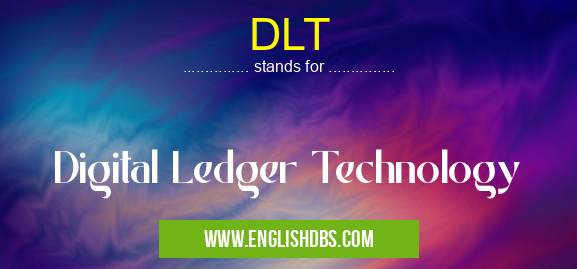What does DLT mean in TECHNOLOGY
DLT stands for Digital Ledger Technology. It refers to a computerized system for recording and maintaining data in a shared and secure manner. Unlike traditional databases, DLTs are distributed, meaning the data is not stored in a single location but is shared across multiple nodes or computers. This decentralized nature provides increased security and transparency, as any changes to the data are recorded on all nodes and can be easily verified.

DLT meaning in Technology in Computing
DLT mostly used in an acronym Technology in Category Computing that means Digital Ledger Technology
Shorthand: DLT,
Full Form: Digital Ledger Technology
For more information of "Digital Ledger Technology", see the section below.
» Computing » Technology
Introduction: Digital Ledger Technology (DLT)
Key Features of DLT:
- Decentralized: Data is distributed across multiple nodes, eliminating the risk of a single point of failure.
- Immutable: Data that is recorded on a DLT cannot be altered or deleted, ensuring its integrity and reliability.
- Transparent: All transactions and data on the ledger are visible to all participants, promoting accountability and trust.
- Secure: The use of cryptographic algorithms ensures the confidentiality and authenticity of the data stored on the ledger.
Applications of DLT
DLT has numerous applications across various industries, including:
- Finance and Banking: Cryptocurrencies, digital asset management, and cross-border payments.
- Supply Chain Management: Tracking goods, ensuring transparency and efficiency in the supply chain.
- Healthcare: Secure storage and sharing of medical records, improving patient care and research.
- Government: Digital identity, land registry, and voting systems.
Essential Questions and Answers on Digital Ledger Technology in "COMPUTING»TECHNOLOGY"
What is Digital Ledger Technology (DLT)?
DLT is an innovative technology that serves as a shared, decentralized digital ledger that records transactions across various participants. Unlike traditional centralized systems, DLT distributes data across a network of computers, making it highly secure and immutable.
How does DLT work?
DLT operates on a peer-to-peer network, where each participant maintains an identical copy of the ledger. Transactions are broadcast and verified by multiple nodes within the network, ensuring consensus and the prevention of fraudulent entries.
What are the key benefits of DLT?
DLT offers several advantages, including:
- Enhanced security: Data is distributed across multiple nodes, making it highly resistant to hacking and data breaches.
- Increased transparency: All transactions are recorded and visible to authorized participants, promoting accountability and trust.
- Improved efficiency: DLT automates processes, eliminates intermediaries, and reduces transaction time and costs.
What are the different types of DLTs?
There are various types of DLTs, each with its unique characteristics. Some common types include:
- Blockchain: A distributed ledger that forms a chain of immutable blocks, with each block containing a timestamp, transaction data, and a reference to the previous block.
- Directed Acyclic Graph (DAG): A type of DLT where transactions are arranged in a graph-like structure, allowing for faster processing and increased scalability.
- Hashgraph: A DLT that uses a gossip protocol to achieve consensus and ensures high throughput and low latency.
What industries can benefit from DLT?
DLT has vast applications across various industries, including:
- Finance: Enhancing transaction security and efficiency in payment systems, asset management, and trade finance.
- Supply chain management: Providing transparency, traceability, and improved coordination among supply chain participants.
- Healthcare: Securing and sharing patient data, improving medical research, and optimizing supply chain management.
Final Words: DLT is a transformative technology that offers significant advantages in terms of security, transparency, and efficiency. Its decentralized and immutable nature makes it well-suited for applications where trust and data integrity are paramount. As technology continues to evolve, DLT is expected to play an increasingly vital role in various industries, revolutionizing the way data is managed and shared.
DLT also stands for: |
|
| All stands for DLT |
